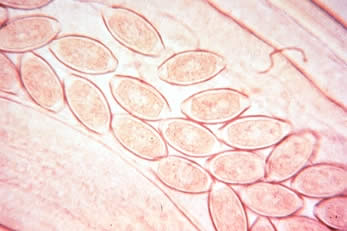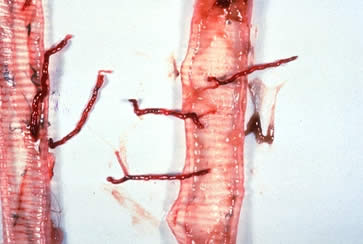Parasitic worms (or Helminths)
Parasitic worms (or Helminths)
All birds are naturally subject to infection by parasitic worms or Helminths. The majority of Helminths infect the digestive tract but some are also found in other organs, such as the brain, trachea and eye. Not all Helminth infections cause obvious clinical disease. The roundworms (or nematodes) and the flatworms (including cestodes and trematodes) are the two major classes of Helminth.
Parasitic worm lifecycles
Parasitic worms have either a direct or indirect lifecycle. Worms that have a direct lifecycle only need to infect a single host species in order to complete their entire lifecycle, although some development may take place outside of the host. Worms that have an indirect lifecycle require two different hosts to complete their lifecycle – the main host and an intermediate host. Worms with an indirect lifecycle spend some of their immature phase in an intermediate host but must then infect the main host in order to be able to reach maturity and reproduce. Some worms may require very specific intermediate and/or main host species.

Roundworms in small intestine Source: The Merck Veterinary Manual

Ascaridia galli eggs Source: The Merck Veterinary Manual

Capillaria eggs in an earthworm as intermediate host Source: The Merck Veterinary Manual
Roundworms (nematodes)

Syngamus trachea (gapeworm) Source: The Merck Veterinary Manual
Roundworms are the most common intestinal worm of commercial poultry and cause the most economic impact. They are called roundworms because they are spindle-shaped and non-segmented with a smooth cuticle or skin. Some may have transverse grooves. With few exceptions, roundworms have separate males and females. Roundworms can have either a direct or an indirect lifecycle. Roundworms that have a direct lifecycle pass through four developmental stages before becoming adults. Mature roundworms living in the infected bird produce eggs (1) that pass in the droppings, where they embryonate (2) in the environment, and when ingested, they hatch (3) in the proventriculus of the host and undergo larval growth (4) to maturity.
Flatworms

Tapeworms Source: Kansas State University
Flatworms that infect poultry include tapeworms (cestodes) and flukes (trematodes).
Tapeworms are white or yellowish ribbon-like segmented flatworms. Tapeworms grow by forming new segments (called proglottids) just behind their head (scolex). Each segment contains both male and female sexual organs. The tapeworm attaches itself to the wall of the intestine with the scolex. As it grows, segments on the tail end mature and break off, passing out of the intestine with the droppings. The excreted segments are filled with “eggs”, which are actually first stage larvae. Tapeworms have an indirect lifecycle. Insects and other arthropods eat the excreted segments and become intermediate hosts for the parasite. Many tapeworms require a specific intermediate host. Poultry become infected by eating infected intermediate hosts.
Flukes are flattened unsegmented, leaf-like parasites. Flukes are hermaphroditic (each individual has both male and female sex organs) and all trematodes that infect poultry have an indirect lifecycle. Their lifecycles vary in complexity and can involve up to four hosts. More than 500 species have been found in birds but only a few are known to cause disease.
Prevention and treatment of parasitic worms

Effects of tapeworm infestation (top) on growth Source: Kansas State University
Control of either class requires accurate species identification and knowledge of the parasite’s lifecycle. Control of worms with indirect lifecycles may require both control in the main and intermediate hosts. As with most diseases, prevention is better than cure and while many parasitic worms can be killed using appropriate medications it is desirable to minimise exposure through good biosecurity management practices. Worms that are transmitted through the oral-faecal route can be greatly reduced by housing the birds on clean wire away from their droppings. In floor-based housing systems stocking rates, shed cleanout and litter and range management are important factors. However, in some cases, such as with the common roundworm (Ascaridia galli), insects such as flies can carry worm eggs and so may also need to be controlled to prevent infection.
Further information
A detailed discussion of the various types of Helminths that infect poultry, including lifecycles, diagnosis and treatment, can be found in the Merck Vet Manual.

